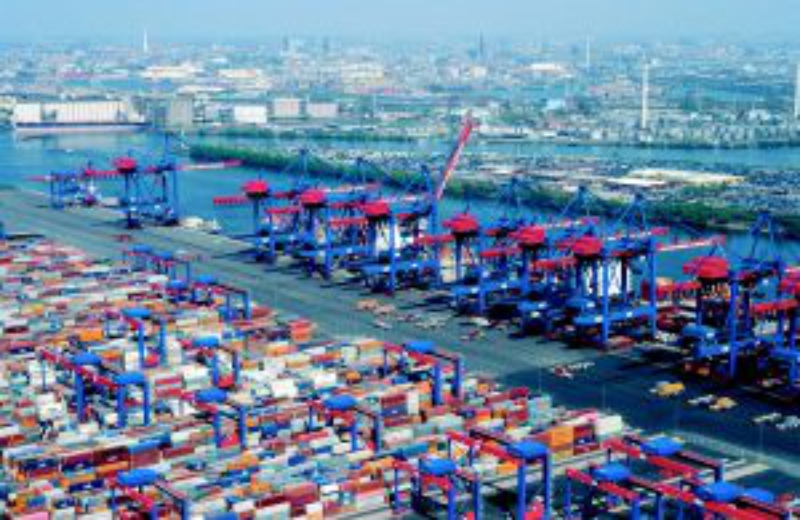• First-quarter seaborne cargo throughput was 7.9 percent lower this year at
31.9 million tons. Container handling reached 2.2 million TEU, down by 6.6 percent.
• Throughput on seaport-hinterland services was less seriously hit by the downturn.
Even Germany’s largest universal port is affected by the repercussions of the corona crisis. Seaborne cargo throughput in the first quarter of the year at 31.9 million tons was
7.9 percent down on 2019. Container handling at 2.2 million TEU was 6.6 percent lower. Container hinterland transport services remains comparatively stable, while the drop in demand for transhipment handling was more obvious.
The Port of Hamburg remains fully operational. In the difficult economic conditions caused by the worldwide corona crisis, the port performs an essential function in maintaining reliable supplies of products and raw materials for the economy and the population. The slackening of import and export flows apparent in Germany’s largest universal port can be explained by the interruption to transport and supply chains caused by the impact of the corona crisis. “The partial shutdown of the Chinese economy, resulting in blank sailings in shipping, has led to lower cargo handling in Hamburg as well,” explained Axel Mattern, Joint CEO of Port of Hamburg Marketing.
Mattern pointed out that the port with its high-performance cargo handling terminals and inland transport services remains fully operational. He expressed thanks for their dedication at a difficult time to the port’s up to 156,000 directly and indirectly employed staff and the companies in the seaport business, who all ensure smooth cargo handling, day in, day out. “We assume that with its large workforce and well-established enterprises, the Port of Hamburg will successfully surmount this crisis,” said Mattern.
In the container handling segment, in the first quarter of 2020 a total of 2.2 million TEU
– 20-ft standard containers – were loaded or discharged across the quay walls of the Port of Hamburg, representing a 6.6 percent downturn on the previous year. Among the Port of Hamburg’s most important partner countries by volume on seaborne container traffic, first-quarter trends varied a great deal. At 579,400 TEU, the total number of containers handled during the first quarter in the Port of Hamburg for China, its most important trading partner, was 14.6 percent lower. “The downturn in seaborne cargo throughput with China is explicable in connection with the repercussions of the corona crisis,” said Mattern.
Following in second place in the ranking of Hamburg’s container partners, in the first quarter the USA accounted for 146,100 TEU, still reporting 20.7 percent growth. “This strikingly good trend in container services with the USA is attributable to four container services newly started from Hamburg at the beginning of 2019. These made excellent progress and ensured larger throughput volumes, above all with US East Coast ports,” said Mattern.
In third place with 111,000 TEU, Singapore also achieved an advance in the first three months of the year. Growth of 10.5 percent was reported for seaborne container traffic. Axel Mattern surmised that the trend can be explained by the transfer of transhipment services from other Asian countries to Singapore.
In Hamburg, by contrast, the transhipment sector, or container throughput between ocean-going and feeder vessels, was especially affected by the corona crisis with a decline of
10.8 per cent to 772,000 TEU. Seaport-hinterland container services by rail, truck and inland waterway craft proved more stable in the first quarter, volume being just four percent lower at 1.4 million TEU. Of such significance for the Port of Hamburg, railborne freight transport, down 4.3 percent at 11.9 million tons, or 4.6 percent at 663,000 TEU, on the first quarter of 2019, was still at a considerably higher level than the 612,000 TEU for I/2018.
“In recent weeks the Port of Hamburg’s superb hinterland connection has played a major part in ensuring that even in difficult times its effectiveness has remained unimpaired,” said Jens Meier, CEO of HPA. “Despite temporarily lower container volumes caused by the corona crisis, in the first quarter the Port Railway was able to report stable utilization and indeed even to improve on the 2018 level. That was by no means to be taken for granted, but is the result of systematically boosting efficiency and continuously expanding the Hamburg Port Railway.”
First-quarter throughput of bulk cargoes was 11.9 percent lower at 9.4 million tons. In this throughput segment, exports performed well, being 11.9 percent higher at 2.7 million tons. The trend was sustained by notable increases in exports of grain, up 177.2 percent at 694,000 tons, and of fertilizers, 8.1 percent higher at 638,000 tons.
For the next few months, Axel Mattern assumes that the Port of Hamburg must initially adapt to a continuation of blank sailings and falling total throughput. “From June, it is entirely possible that with a gradual pick-up in the economy in China and Europe, we shall be seeing an increase in sailings and rising volumes on port throughput and seaport-hinterland services,” asserted a confident Mattern.







